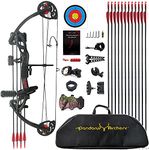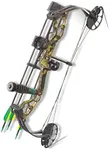Buying Guide for the Best Youth Archery Bow
Choosing the right youth archery bow is crucial for ensuring a positive and safe experience for young archers. The right bow will help them develop their skills, enjoy the sport, and stay motivated. When selecting a youth archery bow, it's important to consider several key specifications to ensure the bow matches the archer's size, strength, and skill level. Here are the key specs to consider and how to navigate them.Draw WeightDraw weight refers to the amount of force required to pull the bowstring back to its full draw length. This spec is important because it affects how easy or difficult it is for the archer to draw the bow. For youth archers, a lower draw weight is generally recommended to ensure they can handle the bow comfortably and safely. Typically, draw weights for youth bows range from 10 to 20 pounds. Beginners should start with a lower draw weight and gradually increase as they build strength and confidence.
Draw LengthDraw length is the distance from the bowstring at full draw to the front of the bow grip. This spec is crucial because it needs to match the archer's arm length to ensure proper form and accuracy. To determine the correct draw length, measure the archer's arm span (fingertip to fingertip) and divide by 2.5. Youth bows often have adjustable draw lengths to accommodate growth and changes in the archer's form. It's important to choose a bow with a draw length that can be adjusted as the young archer grows.
Bow Size and WeightThe size and weight of the bow are important for the archer's comfort and ease of use. A bow that is too large or heavy can be difficult for a young archer to handle, leading to poor form and potential injury. Youth bows are typically smaller and lighter than adult bows, making them easier for young archers to manage. When selecting a bow, ensure it is appropriately sized for the archer's height and strength. A good rule of thumb is to choose a bow that the archer can comfortably hold at arm's length without straining.
Bow TypeThere are different types of bows, including recurve bows, compound bows, and longbows. Each type has its own characteristics and benefits. Recurve bows are simple and traditional, making them a good choice for beginners. Compound bows have a system of pulleys and cables that make them easier to draw and hold at full draw, which can be beneficial for young archers. Longbows are less common for youth but offer a traditional archery experience. Consider the archer's interest and the type of archery they want to pursue when choosing the bow type.
AdjustabilityAdjustability refers to the bow's ability to be modified in terms of draw weight and draw length. This spec is important for youth archers who are still growing and developing their skills. An adjustable bow can grow with the archer, providing a longer useful life and better value. Look for bows with a wide range of adjustability to ensure it can be tailored to the archer's changing needs. This will help maintain proper form and comfort as the archer progresses.
AccessoriesMany youth bows come with accessories such as sights, arrow rests, and quivers. These accessories can enhance the archery experience by improving accuracy and convenience. It's important to consider what accessories are included with the bow and whether they meet the archer's needs. For beginners, a basic set of accessories is usually sufficient, but as the archer's skills improve, they may benefit from more advanced accessories. Ensure the bow is compatible with additional accessories that can be added later.























